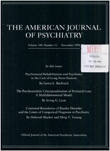The borderline diagnosis in adolescents: symptoms and developmental history
Abstract
Adult criteria for borderline personality disorder distinguished a group of 27 inpatient adolescent girls from 23 nonborderline inpatient female comparison subjects. The two groups were compared on retrospectively assessed variables measuring psychological, familial, and constitutional factors. Variables most likely to predict borderline personality disorder included history of disrupted attachments, maternal neglect, maternal rejection, grossly inappropriate parental behavior, number of mother and father surrogates, physical abuse, and sexual abuse. Families of borderline adolescents were chronically disrupted, particularly during the patients' early childhoods. The traumatic childhood experiences of the borderline adolescents were similar to those of adults with borderline personality disorder in recent studies.
Access content
To read the fulltext, please use one of the options below to sign in or purchase access.- Personal login
- Institutional Login
- Sign in via OpenAthens
- Register for access
-
Please login/register if you wish to pair your device and check access availability.
Not a subscriber?
PsychiatryOnline subscription options offer access to the DSM-5 library, books, journals, CME, and patient resources. This all-in-one virtual library provides psychiatrists and mental health professionals with key resources for diagnosis, treatment, research, and professional development.
Need more help? PsychiatryOnline Customer Service may be reached by emailing [email protected] or by calling 800-368-5777 (in the U.S.) or 703-907-7322 (outside the U.S.).



